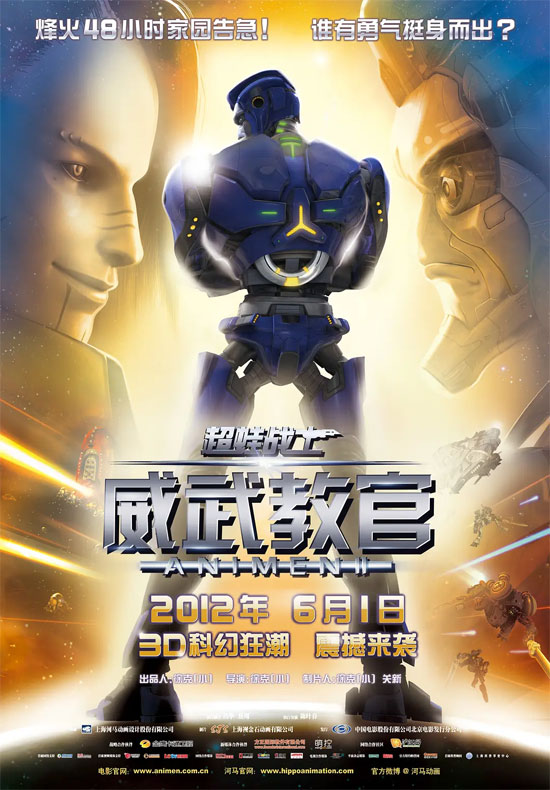Film Name: 超蛙战士之威武教官 / Animen II

As an objective depiction of a localized war, “Animen II” has achieved a domestically leading standard in every aspect—from showcasing 3D technology and designing large-scale machinery to portraying battle scenes and progression. This is undeniable. What I wish to emphasize is that, setting aside the technical superiority of “Animen II” over “Animen I,” the film still fails to transcend the latter’s focus on war for war’s sake in terms of plot, narrative, and most crucially, the humanistic concerns embodied within that plot and narrative.
Compared to “Animen I,” the plot of “Animen II” is largely similar, depicting two battle sequences: one large-scale campaign and one smaller conflict. Beyond these battles, both films include segments depicting daily life: “Animen I” shows several AIU assault team members publicly demonstrating their mechs, while “Animen II” features two small segments about cooking and training. Most of the film’s action unfolds in space—jumps, battle preparations, and combat sequences—making the fighting feel like a black hole, sucking the plot into the boundless darkness of the cosmos. Admittedly, combat can showcase technical prowess, and combat can reveal humanity—in this regard, “Animen II” does improve upon “Animen I” by first depicting the heroic death of a general on the battlefield and the self-sacrificing conviction of Instructor Top. Yet these moments remain confined to individual characters. In other words, after watching “Animen II,” as individuals, we grasped the brilliance of humanity, but as a collective, we failed to discern the war’s true purpose.
The sole meaning I perceived in “Animen II”‘s war was conquest versus resistance. The Ladder Clan existed solely to fascistically conquer the Frog Clan, while the Frog Clan existed solely to resist the Ladder Clan’s conquest and ensure their own survival—nothing more. Therefore, I foresee that the film’s every effort is focused on relentlessly building a sense of urgency before the great war, only to then concentrate its narrative on depicting that so-called earth-shattering conflict. In “Animen I,” the AIU commando member Steel Beast even disregarded his commander’s orders to fight for revenge. While that battle was spectacular, such vengeful emotions dim the true meaning of war.
Sci-fi works require more than just sci-fi elements. After mastering the craft of creating compelling sci-fi material, the next step is to build a civilization system that aligns with it—in other words, a worldview and value system.
Why do I often cite “Robotech” as an exemplar of sci-fi animation? Precisely because it masterfully illustrates a concept transcending massive mecha battles and inter-species conflict—war waged to prevent war. The existence of the Songstress is a crucial element in “Robotech.” When Lin Mingmei’s voice resonates amidst the war, it not only inspires the human warriors but also sends a universal call for peace to all races. Her song embodies the same conviction as love and peace. This is why “Robotech” depicts scenarios of humans and aliens coexisting peacefully, and why aliens ultimately lament Earth’s unsuitability for their survival, retreating to seek new planets. The philosophy of waging war to prevent war amplifies both the grandeur of conflict itself and the enduring human values revealed within it. This perspective fundamentally corrects the inversion where the brilliance of individual humanity overshadows the overarching significance of war.
When Instructor Top charged toward the enemy vessel with self-sacrifice, we gasped at his greatness. We also felt a deep respect for the profound sense of kinship that blossomed between him—an outsider—and the frog tribe. We also felt the tragic grandeur that individual heroism has always evoked. But after all this, when we racked our brains and still couldn’t fathom his purpose (was it merely to repay a debt of gratitude, or just to halt the enemy’s immediate advance?), when we realized his heroic act would alter neither the broader conflict nor the deep-seated hatred between the Ladder Tribe and the Frog Tribe, when we saw clearly that in the Super Frog saga, war rages purely for war’s sake—that mutual hatred persists regardless of its end—we felt even more profoundly how truly insignificant such a feat truly was.
I particularly cherish a scene in “Animen I” where Cannon’s grandmother calls him during the war’s most critical moment, uttering words starkly at odds with the chaos of battle. It is precisely this contrast that elevates “Animen I”‘s perspective on war—though this elevation remains fleeting, not consistently explored throughout the series. Regrettably, such brilliant vignettes are absent from “Animen II,” replaced instead by pure, relentless charging and sacrifice.
Another highlight of “Animen II” is the intricate power struggles between its two antagonists, which deepens the narrative complexity and enriches the conflicts. Personally, I find the newly introduced villain Lipton (though he appeared in the TV anime) exceptionally well-crafted in characterization, performance, and voice acting. However, “Animen II” could benefit from refining its cinematic approach in certain areas where scenes feel overly isolated, appearing more like showy set pieces with weak narrative cohesion. For instance, the “Dong Dong Qiang” song sung by Big Cannon while cooking would have been far more effective if revisited during a later battle scene, rather than existing solely as a standalone comedic moment. This sense of isolation likely stems from the film being condensed from multiple TV anime episodes.
Please specify:Anime Phone Cases » Animen II 2012 Animation Film Review: Do not wage war for the sake of war.